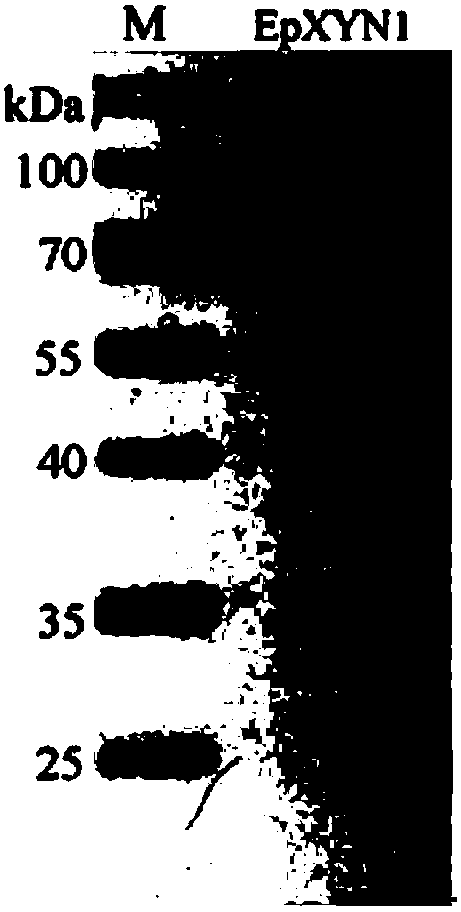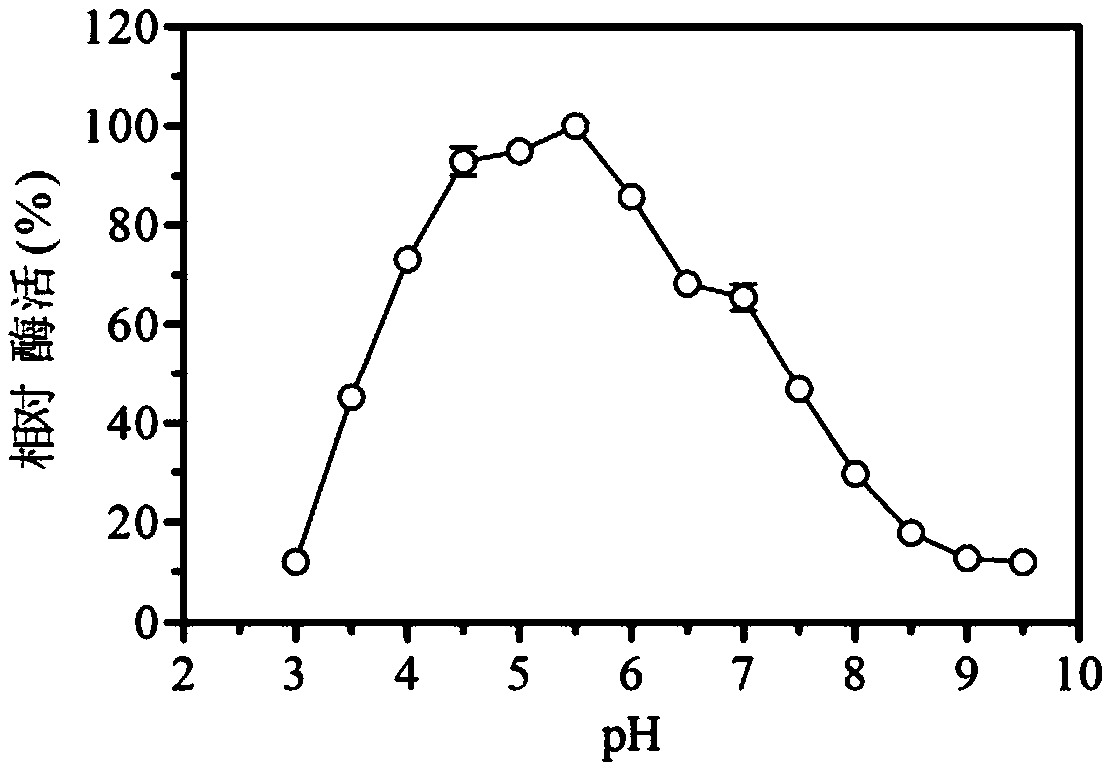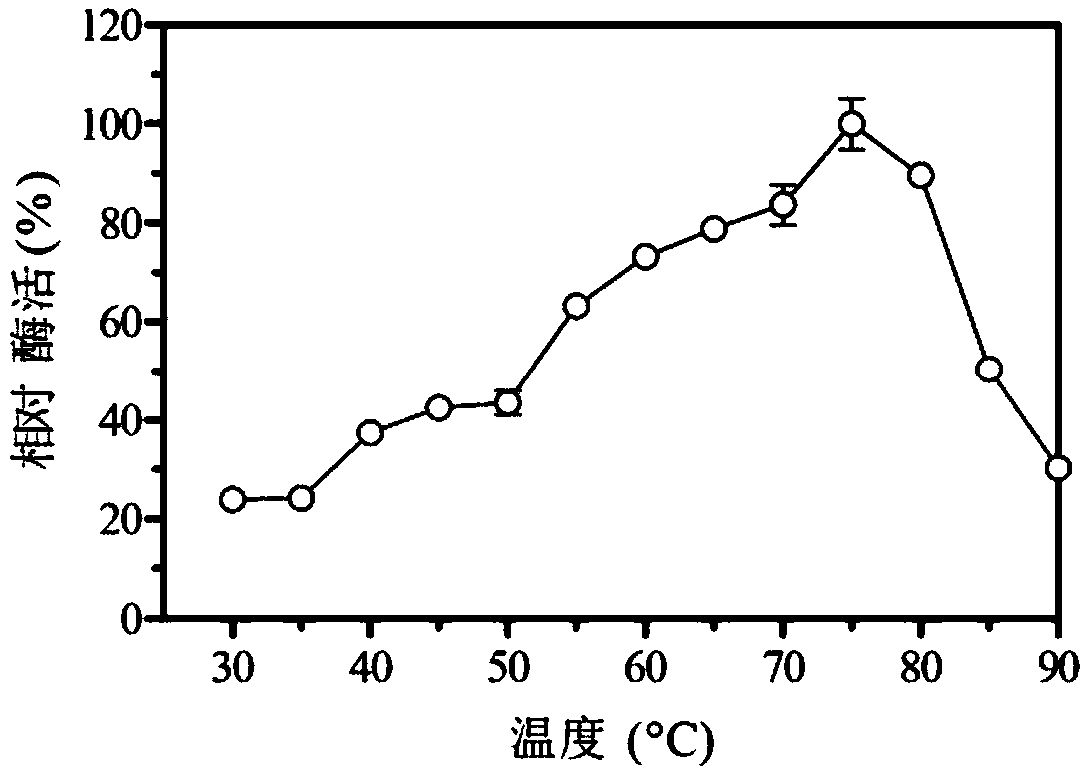High-temperature-resistant endoxylanase EpXYN1, coding genes and application thereof
A technology of endo-xylanase and xylanase, which is applied in the field of genetic engineering, can solve problems such as difficult to withstand high temperature conditions, and achieve the effects of high specific activity, high enzymatic hydrolysis efficiency, and high stability
- Summary
- Abstract
- Description
- Claims
- Application Information
AI Technical Summary
Problems solved by technology
Method used
Image
Examples
Embodiment 1
[0029] Cloning of the gene encoding the thermostable endo-xylanase EpXYN1 of embodiment 1
[0030] Fungal culture and total RNA extraction: take about 10 9 The spores of the 4-14 strains of Penicillium pumilus were inoculated into 50mL PDA liquid medium, and cultured at 37°C and 180rpm for 4 days. Take 1 mL of the culture into a bottle of solid-state fermentation medium (L.Long, D.Ding, Z.Han, H.Zhao, Q.Lin, S.Ding, Thermotolerant hemicellulolytic and cellulolyticenzymes from Eupenicillium parvum 4-14 display high efficiency upon Release offerulic acid from wheat bran, J.Appl.Microbiol.121(2016) 422-434.), shake well and place it under the conditions of 37°C and 70% humidity for static culture for 3 days. After the white mycelium was rinsed with sterile water, the water was blotted with filter paper, frozen in liquid nitrogen and stored at -70°C. Total bacterial RNA was extracted with TransZolTM Plant Kit (TransGen, Beijing).
Embodiment 2
[0033] Example 2 Expression and purification of thermostable endo-xylanase EpXYN1 in Pichia pastoris
[0034] The specific primers enXyn1_f2 and enXyn1_r2 of endoxylanase EpXYN1 were designed and synthesized respectively, as follows:
[0035]enXyn1_f2: 5′-agagaggctgaagctgaattctcaggcctggatacagcggca-3′;
[0036] enXyn1_r2: 5'-gagatgagtttttgttctagatcagtgatggtgatggtgatgcagacattgagagtacca-3'.
[0037] The endoxylanase EpXYN1 gene fragment without signal peptide was amplified from the plasmid containing the endoxylanase EpXYN1 gene by using the pair of primers. The amplified target gene fragment was gel-cut and purified, and passed through HieffClone TM The One Step Cloning Kit (Yeasen, Shanghai) performed homologous recombination with the EcoRI-XbaI digested plasmid pPICZαB to obtain the gene expression plasmid pPIC-EpXyn1. After the recombinant plasmid pPIC-EpXyn1 was linearized with restriction endonuclease SacI and then electroporated into Pichia pastoris KM71H, positive clo...
Embodiment 3
[0038] Example 3 Establishment of an activity assay method for thermostable endoxylanase EpXYN1
[0039] Using Beechwood xylan as substrate, Somogyi-Nelson method was used to measure reducing sugar content and calculate enzyme activity. The 1.5mL reaction system is: 1.0mL 50mM pH 5.0 sodium citrate buffer solution, 400μL 0.5% (w / v) substrate, mix gently and preheat for 10min, then add 100μL crude enzyme solution (pre-diluted to different gradients) multiples), the reaction time is 10min at 75°C. Then take it out one by one, add 500μL Somogyi Reagent solution, put it in a 99°C water bath for 15min, cool it to room temperature, add 0.5mL Nelson Reagent, react for 20min, centrifuge for 10min, draw 200μL onto the microplate, and place it in a microplate reader Measure the absorbance (OD value) of the sample at a wavelength of 520 nm. Simultaneously, prepare different concentrations of xylose solutions, measure the OD of each xylose solution with the above-mentioned method (Somog...
PUM
| Property | Measurement | Unit |
|---|---|---|
| molecular weight | aaaaa | aaaaa |
| molecular weight | aaaaa | aaaaa |
Abstract
Description
Claims
Application Information
 Login to View More
Login to View More - R&D
- Intellectual Property
- Life Sciences
- Materials
- Tech Scout
- Unparalleled Data Quality
- Higher Quality Content
- 60% Fewer Hallucinations
Browse by: Latest US Patents, China's latest patents, Technical Efficacy Thesaurus, Application Domain, Technology Topic, Popular Technical Reports.
© 2025 PatSnap. All rights reserved.Legal|Privacy policy|Modern Slavery Act Transparency Statement|Sitemap|About US| Contact US: help@patsnap.com



